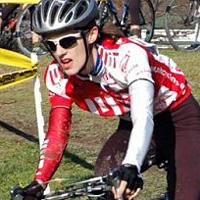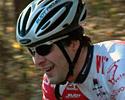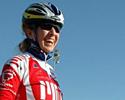
Recently on Cyclingnews.com |
Cyclo-cross feature: October 10, 2007
Against odds: MIT Cyclo-cross campaigns for consecutive national title
Cyclo-cross hardly comes close to the fast, efficient elegance of the team time trial, for which the Team Massachusetts Institute of Technology cycling team is best known. Intrigued by 'cross, two years ago, its members started racing in earnest, and made their way to the top of the podium at the 2006 Cyclo-cross National Championships. "National Champion" and "MIT" don't often fall in the same sentence in terms of collegiate sports, but it makes perfect sense once you strip away training metrics and reveal what makes these cyclists tick. Wendy Booher examines the collegiat 'cross team as its season gets underway.

|
One of the most prolific teams in collegiate racing, MIT Cycling forged its reputation as a force to reckon with in the team time trial by emphasizing efficiency over power. For the 2006 road season, the team meticulously engineered standard techniques for all race and pre-race situations plus staged weekly TTT specific training and designed homemade equipment with empirical fitting. Its finely tuned efforts yielded results at the 2006 Eastern Collegiate Cycling Conferences where the women placed first and the men placed second. The women went on to clinch the third podium position at nationals in both 2006 and 2007 while the men placed fifth in 2006.
Not every school has a wind tunnel like MIT, however MIT's Wright Brothers Wind Tunnel is usually reserved for student projects, research and instruction, and not for the use of a club sport like cycling. The tunnel is available for commercial research and development for a fee, which is something the CSC professional team took advantage of before the 2006 season. Luckily, MIT Cycling was afforded a rare wind tunnel test visit through Mark Cote, a team member and research assistant at MIT's Center for Sports Innovation and Technology. The resulting data likely contributed to MIT's TTT successes.
Cyclo-cross on the other hand, is practically the antithesis of the grace and fluency of the TTT. Aerodynamic profiles be damned; cyclo-cross demands a power and pain tolerance that defy calculation – how very un-MIT. However, forget about hackneyed, overdone clichés about MIT's legacy "nerd-ness." Do, however, consider for a moment the magnitude of groundbreaking innovation that emerges from MIT, ranging from urban planning and aeronautics to gene therapy, and suddenly it becomes personal, especially when those technologies apply to bike lanes, faster time trials and regrettably, new methods of doping.

|
MIT's 4,000 graduate students largely fuel the engine driving all that innovation. Luckily, an inspired few have applied that same intellectual drive and motivation to another one of their passions and the result is a cycling team that frequently enjoys the view from the podium in four disciplines. Based on student body size, colleges are categorized as Division 1 or II. With nearly 10,000 students, MIT falls into Division II status. Few D II schools can boast a team that competes in road, track, mountain biking, and cyclo-cross, and even fewer schools consistently have racers who routinely place in the top five. To write the team off simply as "overachievers" would be unfair – even untrue since the ability to accept failure drives innovation, and MIT doesn't hand out PhD's for shoddy work.
What sets the MIT cycling team apart from nearly every other collegiate team is a constant, self-possessed pressure to seek out solutions rather than stay mired in conflict.
Unlikely national champions
When the Cyclo-cross National Championships came to Providence, RI in 2005, MIT Cycling dispatched a team of eight to see how close they could come to the podium in the collegiate category, which lumped together both DI and II teams. Several team members had never raced 'cross before and few actually owned 'cross bikes yet they determined that a podium spot was within reach if racers placed within the top 20. In essence they conquered by numbers and earned fifth place next to schools with more students and bigger team budgets.
The team returned to nationals in 2006 – this time with 10 racers – and the podium's top spot as the target, which became a different task now that DI and DII teams were scored separately. However, there were big changes in cyclo-cross between 2005 and 2006. More people began racing 'cross, fields were bigger and competition was stiffer. This time though, the team sharpened its preparation for nationals and arrived in Providence stronger and more experienced than before. However, MIT cyclists proved long ago that strength and experience are not the only things that make a racer go fast.
Known for their analytical approach to and proven success in the TTT, MIT cyclists indulge in a fair amount of left-brained musings about cyclo-cross as well.
"What really sets cyclo-cross apart from road or mountain biking is the energy-time challenge," said Nick Loomis, captain of last year's national champion team. "When you come to an obstacle, you have to evaluate whether it would be energetically advantageous to ride it or run it, and whether the trade-off in energy usage is beneficial to your overall time. It's a huge optimization problem. A good course makes you continually reconsider the trade-off."
Grabbing at fistfuls of pain

|
In more barbaric terms, if you are willing to risk crashing, vomiting and even blacking out, then 'cross is for you. Mastering new thresholds of pain might explain the seduction of 'cross but once the bar gets raised, along comes someone to raise it even higher. The team seems to be in agreement that few people can raise that bar higher than Eric Edlund, who can reach further into the depths of suffering than most masochistic 'cross racers.
"It's kind of a dark story," said Edlund. "I derive some motivation to dig deep from past experiences where I've almost died due to my own stupidity. Racing is a catharsis, a chance to revisit gut-wrenching pain out of free will, a chance to make amends for those dark points in my past."
During the 2006 collegiate road season, Edlund scored points in all men's categories. These days he continues to collect wins in various regional races. He has also applied his distinct competitive prowess to track and mountain bike racing and has done exceptionally well in those disciplines too.
Dope theory
One of the leading institutions in the world for bioengineering and biotechnology, MIT might raise a few eyebrows in the sporting world due to its genetic research facilities. Following the 2004 Olympics, the prospect of genetically engineering future gold medallists stirred suspicions but Edlund's team-mate, Eli Papa, who works with Harvard/MIT's Health Sciences and Technology Institute and who is the captain of this year's cyclo-cross team, quickly debunks the notion of genetically engineering Olympians.
"When and if you integrate a gene you also have to express it," explained Papa. "As long as you can successfully deliver a gene and actively express it, it could arguably be used to alter physiological characteristics.
"But before technology like that can be successfully employed in humans, it would have to first pass careful clinical trials. The negative side effects of any genetic therapy could be very broad and have yet to be explored in detail."
There is a more practical approach to 'cross racing, as explained by Natalia Gardiol, one of the team's most dynamic racers who races road, track, mountain bike and 'cross, and who does well in each. Gardiol's research in models of sequential decision-making systems resonates with her ability to tailor racing technique to varying race conditions.
"On the one hand, you know that you're in for about 45 minutes and then it's over. So you 'only' have to train your body for exactly that length of effort," said Gardiol. "However, every time you show up for a race, it's a different game. 'Cross makes you tap into a combination of skills – more than you would find in just road racing. So, when you show up at a new course, you focus more on your technique and less on the suffering. Also, 'cross is still beautifully on the fringe; it's not as full of itself as more mainstream things. This makes it easier to keep a sense of humour."
What's missing

|
Remarkably, despite attending one of the most prestigious academic institutions in the world, the team utterly lacks pretentiousness. In terms of marketing itself, team members "get it" and choose to treat the team as a corporation rather than relying on the reputation of the school. A thriving online store, vigorous communication with alumni, sponsors and supporters, and a professionally-crafted sponsorship proposal distinguish MIT but, as actions do often speak louder than words, it's the exposure in road, track, mountain bike and 'cross racing that lodges the greatest impression.
"We hold high value in every partnership, grassroots or otherwise, because we want a great partner who will help us promote our products and our brand," said Michael Zellmann, PR and media manager at SRAM. "We assumed they were smart and not because they attend MIT, but because they applied for SRAM Grass Roots Sponsorship."
Few bike manufacturers can respond to the demand for such a wide range of bikes and in a sense, bike sponsor Fuji helps MIT set new goals in racing by providing the tools to achieve those goals.
"For Fuji, having collegiate teams ride our bikes is great not only in terms of publicity but from a personal marketing standpoint," said Fuji's Karen Bliss, who was a collegiate racer herself. "Having this demographic recognizes the integrity and quality of the brand at an 'impressionable' age hopefully translates into great word-of-mouth PR and eventually more sales."
Army in pursuit of the national title

|
One of those goals falls on December 16 when the national title will be contested at the 2007 Cyclo-cross National Championships in Kansas City. The location change will likely draw out local DII teams to challenge the MIT squad. There is a rumour that Army seeks to topple MIT from the podium's top spot and, while budget limitations could hamper the team's campaign for a consecutive national title, at the moment, MIT plans to send at least eight racers to bring back the champion's jersey.
Beyond the practical applications and pain tolerances that distinguish MIT cyclists, there exists a profound craving to locate individual strengths and exploit them for the sake of the team. Unity and an intrinsic capacity for solving problems stomp on stereotypes. Add to that the sinewy, muscular physique of a bike racer, and the team proves that MIT Cycling is anything but cliché.
MIT Cycling 2007 Cyclo-cross team: Caitlin Bever, Ilana Brito, Sonya Cates, Eric Edlund, Natalia Gardiol, Nick Loomis, Kristen Naegle, Eli Papa, Jason Sears and Cimarron Wortham
Photography
For a thumbnail gallery of these images, click here
Images by mitcycling.org
- Nationals Champs L-R: Chris Tracy, Ilana Brito, Kristen Naegle, Natalia Gardiol, Cimarron Wortham, AJ Schrauth, Nick Loomis, Jason Sears, Eric Edlund, David Lafferty
- Racers don't get all the punishment one of the casualties of 'cross
- Caitlin Bever To her rivals: you're in luck! She's graduating soon
- Ilana Brito
- Jason Sears
- Kristen Naegle
- Natalia Gardiol
- Nick Loomis Captain of the 2006 national champion team
- Sonya Cates
- Cimarron Wortham
Images by Keith Berkoben/phoben.com
- Eric Edlund showcases a new style of 'cross training
